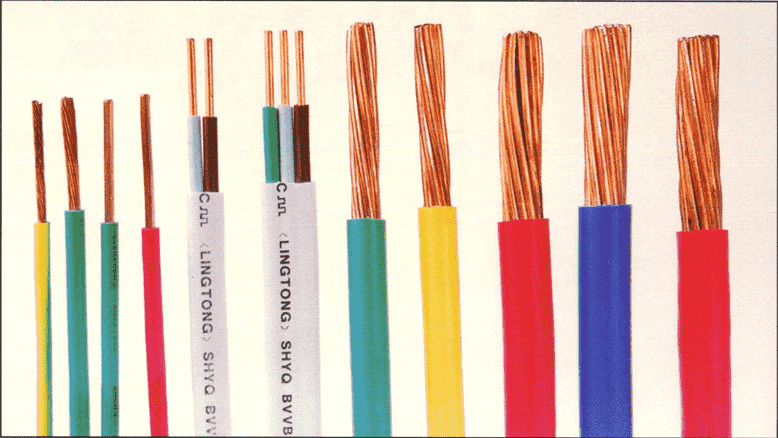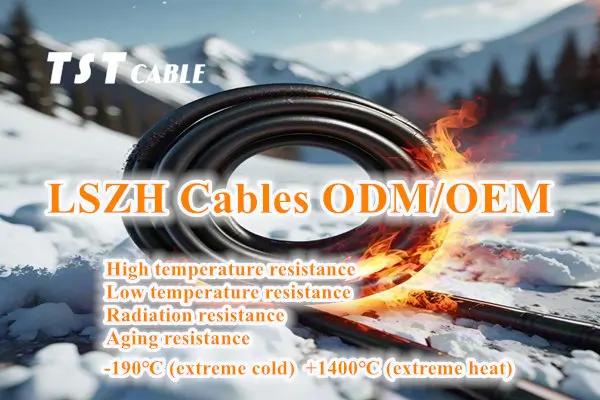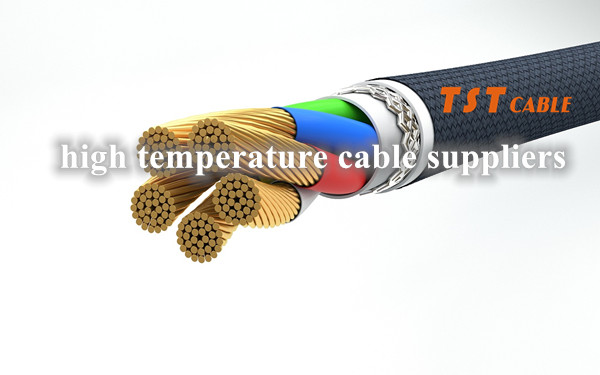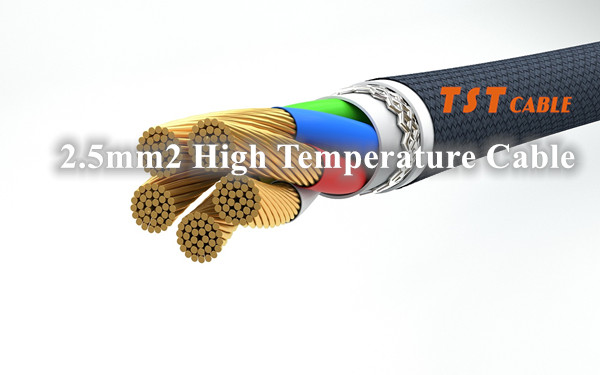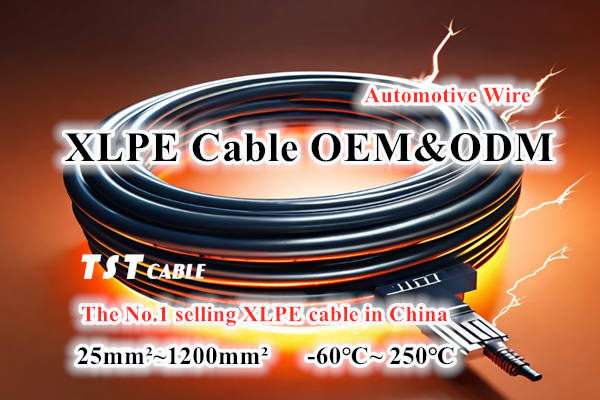
Analysis of Core Parameters and Industry Application Scenarios for Low-Smoke, Halogen-Free, High-Temperature Power Cables
In modern industrial and residential buildings, safety, environmental friendliness, and reliability have become core considerations in power system design. TST CABLE’s low-smoke, halogen-free (LSZH) high-temperature power cables, due to their exceptional performance in emergency situations like fire, are becoming the preferred cable product for key sectors such as rail transit, high-rise buildings, data centers, and the petrochemical industry.
TST CABLE will provide an in-depth analysis of the core parameters of low-smoke, halogen-free, high-temperature power cables and, based on actual needs, provide a practical buying guide. It will also help you understand their typical application scenarios across various industries.
1. What is low-smoke, halogen-free, high-temperature power cable?
Low-smoke, halogen-free, high-temperature power cable uses special materials that do not contain halogens (such as chlorine and fluorine) for its insulation and sheath. It possesses the following three key characteristics:
Low Smoke: Produces minimal smoke during combustion, improving visibility and saving valuable time for evacuation and fire rescue efforts.
Halogen-Free: Contains no halogen compounds and produces no toxic or corrosive acidic gases (such as HCl) during combustion, protecting personnel and precision equipment.
High Temperature Resistance: Able to operate stably and for extended periods at high temperatures (common operating temperatures can reach 90°C, 105°C, 125°C, 250°C, and even higher), making it suitable for locations with high heat generation or ambient temperatures.
II. Core Parameter Analysis: Six Key Indicators to Consider When Purchasing
To select the appropriate low-smoke, halogen-free, and high-temperature power cable, you must thoroughly understand the following core parameters:
Parameter Category Key Indicator Analysis and Selection Points
1. Conductor Specifications – Conductor Material (Copper/Aluminum)
– Cross-sectional Area (mm²)
– Conductor Structure (Single-core/Multi-core) – Copper conductors offer excellent electrical conductivity and high mechanical strength, making them the mainstream choice.
– Select the appropriate cross-sectional area based on load current and voltage drop requirements to avoid overload.
– Multi-core cables facilitate wiring and are commonly used in control circuits; single-core cables are used for high-power transmission.
2. Insulation and Jacket Materials – Material Type (e.g., cross-linked polyolefin (XLPO), irradiated cross-linked polyolefin, etc.)
– Rated Operating Temperature – XLPO is the most common low-smoke, zero-halogen material, offering heat resistance, flame retardancy, low smoke, and non-toxic properties.
– Verify the cable’s maximum long-term operating temperature (e.g., 90°C, 105°C, 125°C) to ensure it meets site environmental requirements.
3. Flame Retardancy and Fire Resistance Rating – Flame Retardancy Rating (e.g., WDZC, WDZB, WDZA)
– Fire Resistance Rating (e.g., N, NH, BS EN 50200 PH120/PH30, etc.) – WDZC: Standard flame retardancy; WDZB: Medium flame retardancy; WDZA: High flame retardancy, suitable for high-risk areas.
– Fire-resistant cables can maintain circuit integrity for a period of time (e.g., 90 minutes) during a fire, making them crucial for fire protection systems. 4. Electrical Performance – Rated Voltage (U₀/U)
– Insulation Resistance
– Dielectric Strength – Common low-voltage cable rated voltages are 0.6/1 kV.
– High insulation resistance and dielectric strength ensure safety and reliability, preventing leakage and breakdown.
5. Mechanical and Environmental Performance – Tensile Strength
– Bending Radius
– Waterproof, Oil-Repellent, and UV-Resistant Ratings (IP/IK) – Flexibility and fatigue resistance are important in environments subject to vibration, movement, or frequent bending (such as equipment rooms and factories).
– UV protection is required for outdoor installation; a waterproof sheath is required for humid environments. 6. Certifications and Standards – National Standards (GB/T 19666, GB 31247)
– Industry Standards (e.g., TB/T, EN 45545-2)
– 3C Certification, CRCC Certification, etc. – GB 31247 “Classification of Flame-Retardant and Fire-Resistant Wires and Cables” is a mandatory standard. Starting July 1, 2025, flame-retardant cables must be 3C certified.
– Rail transit projects must comply with international standards such as EN 45545-2.
III. Industry Application Scenarios: Why are they essential in these areas?
TST CABLE’s low-smoke, halogen-free, and high-temperature power cables, with their safety and environmental advantages, are indispensable in the following applications:
Rail Transit (subways, high-speed trains, and EMUs)
Applications: Internal carriage wiring, signaling systems, control systems, and lighting systems.
Reason: In the event of a fire in an enclosed space, the toxic smoke released by traditional cables can quickly cause asphyxiation. Low-smoke, halogen-free (LSZH) cables significantly improve passenger escape rates and are the “lifeline” of rail transit.
High-rise and large public buildings (office buildings, hospitals, shopping malls, schools)
Applications: Main power distribution lines, emergency lighting, fire pumps, and smoke exhaust systems.
Reason: Crowded areas make evacuation difficult. Using LSZH, fire-resistant cables ensures the normal operation of critical systems in the event of a fire, minimizing secondary damage.
Data centers and communication hubs
Applications: Server cabinet power supplies, UPS systems, and network equipment connections.
Reason: Precision electronic equipment is sensitive to corrosive gases. LSZH cables do not produce acid when burned, maximizing the protection of valuable IT assets.
Petrochemical and industrial plants
Applications: Control cabinets, instrument signal lines, and power supply in high-temperature areas.
Reason: Risks of flammability and explosion, coupled with high ambient temperatures. LSZH cables are not only flame-retardant but also operate stably at high temperatures, ensuring production safety.
Tunnels and underground projects
Applications: Lighting, ventilation, and surveillance system cables. Reason: The space is narrow, long, and enclosed, with poor ventilation. Low-smoke properties are crucial for preventing smoke accumulation and maintaining visibility of escape routes.
IV. Purchasing Recommendations Summary
Clarify Requirements: First determine the voltage level, current load, installation environment (indoor/outdoor, dry/humid, high/low temperature), and whether fire resistance is required.
Focus on Certifications: Prioritize products that have passed national mandatory certifications (such as 3C) and industry-specific certifications to ensure quality compliance.
Brand and Manufacturer: Choose a reputable manufacturer with standardized production practices. Check for successful case studies and test reports.
Cost Tradeoff: Low-smoke, halogen-free cables are generally more expensive than ordinary PVC cables, but the safety benefits they offer far outweigh the cost difference. Their value should be evaluated from a full lifecycle perspective.
Professional Consultation: For complex projects, we recommend calling or emailing a TST CABLE electrical engineer or cable supplier’s technical experts for customized selection.
With stricter environmental regulations and increased safety awareness, low-smoke, halogen-free, and high-temperature power cables have gone from being an “option” to a “must-have.” Properly understanding and selecting these products is not only about meeting regulatory requirements but also about ensuring the safety of life and property.
Also available in:
English


